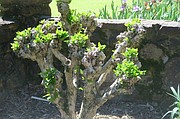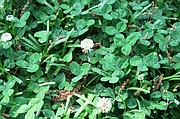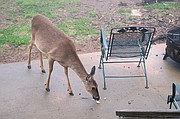Q I have an ornamental sumac that needs ... something. I know their growth structure is "organic" to say the least, but mine is completely one-sided. It is about 5-foot-by-5-foot and about 5 years old. I'm wondering if I could cut it off, say 4-12 inches from the ground in hopes of new branches coming out in a more balanced look. I wouldn't even care if sprouts came up from the ground around it. I would appreciate your opinions.
A Ornamental sumacs usually have multiple canes that come from the soil. They will begin to sucker over time as well. To rejuvenate a cane-producing plant thin out at least one-third of the older, larger, woodier stems at the soil line. You can also prune some of the remaining ones back a bit from the top if they are really one-sided. By thinning the old canes out, you should get new sprouts at the base and can begin to fill the plant back out. If it is really unsightly you could be drastic and take the whole thing back to the ground, but I am afraid it might lead to intense suckering. Removing old canes all the way to the soil line is needed, not 4-12 inches up. Prune them soon, as new growth is moving fast.
Q Is it too late to prune my rose of Sharon? New leaves are coming out.
A Everything has suddenly burst into new growth. If the plant really needs pruning, do so as soon as possible. Late pruning won't hurt your bush, it will just delay the first blooms.
Q I'm considering using clover as a ground cover on a sloping 30-by-40-foot area that has been mulched for the last 17 years. I'd appreciate your guidance on the best clover variety, the pros and cons, and whether deer would tear it up. I enjoy your column and its advice. I live in Northwest Arkansas.
A There has been a lot of interest in recent years in adding clover into the mix for a more diverse lawn alternative. I have had patches of white clover in my yard for years, and they stay green almost year-round, but in patches, not a solid lawn. I have never seen a solid clover hillside, so not sure if that is really a viable option long-term. Start small and try planting a little white clover -- Trifolium repens, which is a perennial -- in one section of the slope to see how it does. Two varieties that the University of Arkansas at Fayetteville have tested with good results are 'Durana' and 'Resolute.' I would mix it in with something else, perhaps some buffalo grass? Is the area sunny or shady? If shady, neither one will work.
Q Bella Vista is a wonderful place to live, but a very trying experience with gardens. When you love flowers and spend money for good plants and, the next day, see them gone, it is so tiring. We have a game camera, and it's deer eating all my plants. I have tried many things from nurseries, but not any work. The last thing I've done is human hair out by my plants. Do you have anything that will be sure to work?
A Short of fencing the garden completely or using an electric fence, nothing is 100% fool-proof on deer. There are a lot of products on the market, and some work for some gardeners, while others don't. Experiment. I know of some gardeners who have luck with a mixture of milk and water, or eggs and water. Many of these sprays have to be reapplied after a rain. There are some plants that are more resistant to deer, but that doesn't mean they won't nibble if they get desperate. Here are some plants to try: Most herbs are not attractive to deer, from rosemary and thyme to lavender and sage. For bulbous plants, daffodils for spring, peonies for late spring and bearded irises are usually left alone. Perennial plants with good resistance include lamb's ear, ornamental salvias (a huge range of sizes and flower colors), butterfly weed (milkweeds), yarrow, beebalm (monarda), catnip and coreopsis. All of those are for the sun, but you can also use hellebores, foxglove, bleeding heart, lungwort and cranesbill geraniums for shade. For shrubs, try boxwoods, hollies, mahonia, cherry laurel, witch hazel, smoke tree and butterfly bush (buddleia). Annuals they usually leave alone include lantana, marigolds and petunias.
Retired after 38 years with the University of Arkansas Cooperative Extension Service, Janet Carson ranks among Arkansas' best known horticulture experts. Her blog is at arkansasonline.com/planitjanet. Write to her at P.O. Box 2221, Little Rock, AR 72203 or email
jcarson@arkansasonline.com
HomeStyle on 04/04/2020



